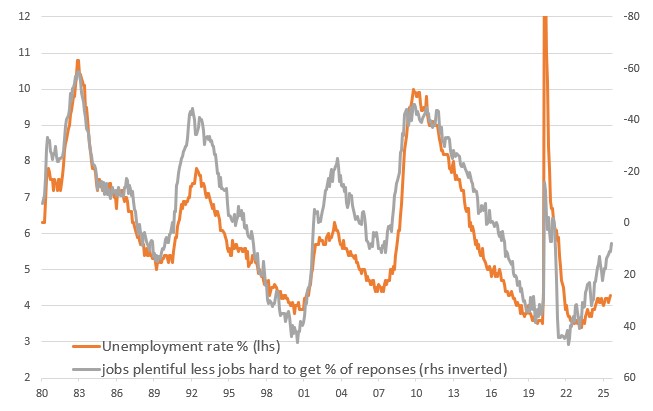Subdued Sentiment Limits The Upside For US Growth

Image Source: Pexels
Slowing jobs market suggests sub-3% wage growth ahead
Today's US data releases have a slightly dovish tinge, with consumer confidence falling more than expected, house prices falling for a fifth consecutive month and while job openings were a touch higher than expected, the quits rate dropped to just 1.9%. The quits rate, in itself, is historically the best guide for wage growth in the US as it is essentially a metric for labour market turnover and reinforces the sense of a cooling jobs market – if your staff aren't quitting, there is no need to offer bumper pay rises. Below is the chart of the quits rates (the proportion of workers quitting their job to move to a new employer each month) versus private wage growth YoY%. This is important because in a service sector-led economy, such as the US, wages are the biggest cost input and softer wage inflation coupled with slowing rents and falling energy prices, we believe, will be key factors that mitigate the impact of goods inflation from tariffs.
Slowing quits rate suggest wage pressures will diminish further

Source: Macrobond, ING
Consumer confidence consistent with 1.5% real spending growth
Regarding the Conference Board measure of consumer confidence, we focus on the expectations component as this has a decent correlation with consumer spending and the chart below shows that the current level is historically consistent with real consumer spending growth of around 1.5%. It isn’t terrible, but given consumer spending accounts for 70% of US economic activity, and we are used to growth rates of 3-4%, it is noticeable. We attribute the softness in spending to concerns about prices, incomes and wealth. While tariffs have been slow to impact inflation, there remains some nervousness that tariff-induced price hikes will come and will squeeze spending power, leading to a lower standard of living. Secondly, there are concerns about job market prospects and, thirdly, while equity markets are at all-time highs, the largest store of wealth for most Americans is in the value of their home and, after five consecutive drops, this may become more of a worry for homeowners.
Consumer confidence & spending

Source: Macrobond, ING
Workers are worried about jobs
Regarding the jobs market and with the risk that Friday’s jobs report doesn’t get released due to the likely government shutdown, the Conference Board’s measure of consumer perceptions of the jobs market is important. The difference between the proportion of people thinking jobs are "plentiful" less the proportion that think jobs are "hard to get" has historically been a key lead indicator for the direction of the unemployment rate – workers tend to see and feel changes in the labour market before they show up in the data. Unfortunately, it deteriorated further in September, just as the University of Michigan sentiment measure did last week. It suggests the risks are that we see the unemployment rate creeping higher in coming months.
Consumer perceptions of the jobs market versus the unemployment rate (%)

Source: Macrobond, ING
Putting this altogether, we have a situation whereby consumers are nervous about the economic situation, despite last week's activity data looking pretty good. At the same time, the fears of a tariff-led pick-up in inflation are yet to materialise, while factors that could help to offset it – energy, wages and housing rents – have more time to exert a dampening effect on inflation over the medium term. This suggests to us that it offers the Federal Reserve the room to continue cutting interest rates to head off the threat of a more pronounced downturn in jobs. We look for October and December 25bp interest rate cuts.
More By This Author:
RBA Holds Rates Steady As Inflation Heats Up And Growth OutperformsFX Daily: US Government Shutdown To Favor The Yen
China’s Manufacturing PMI Continued To Improve In September
Disclaimer: This publication has been prepared by the Economic and Financial Analysis Division of ING Bank N.V. (“ING”) solely for information purposes without regard to any ...
more


